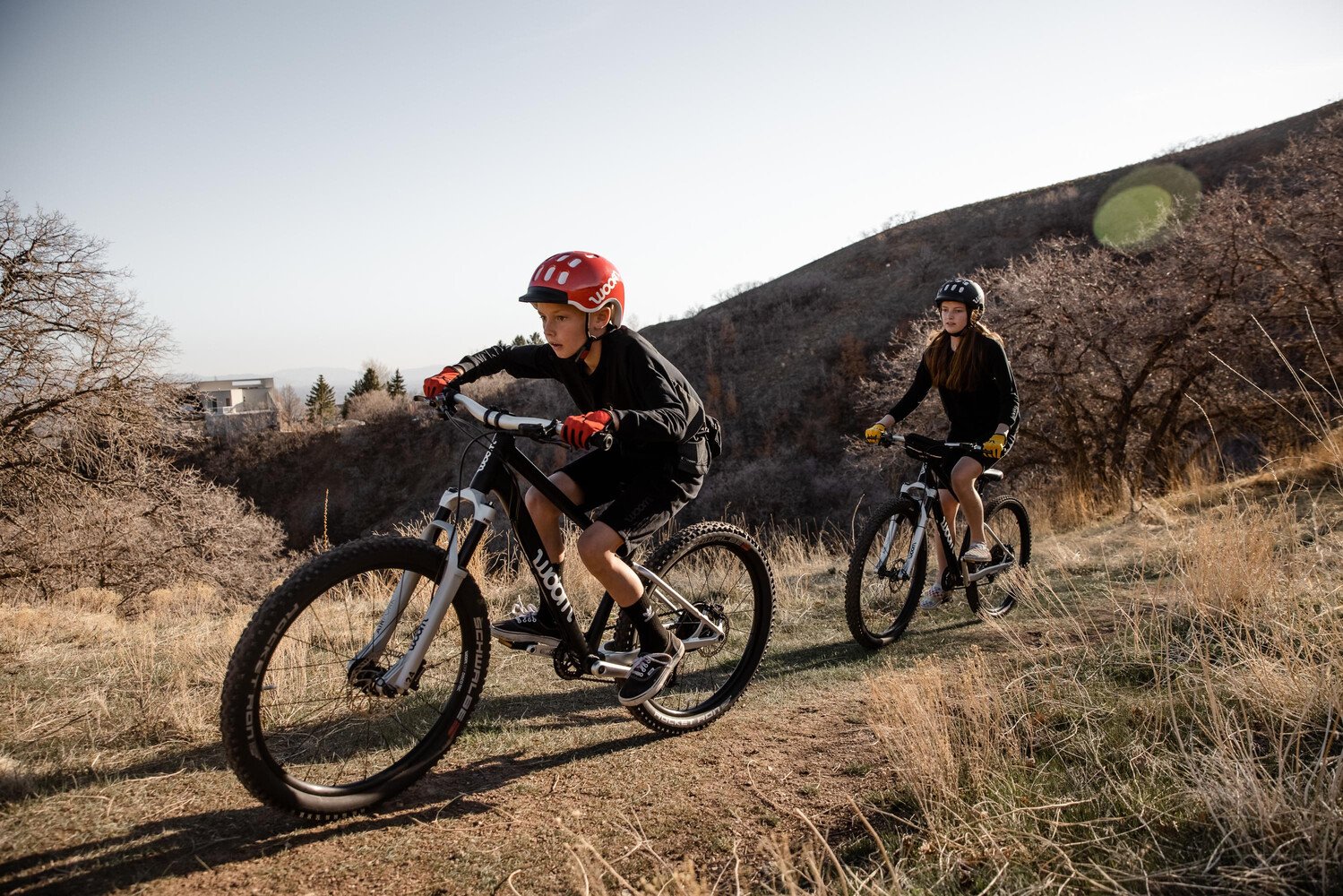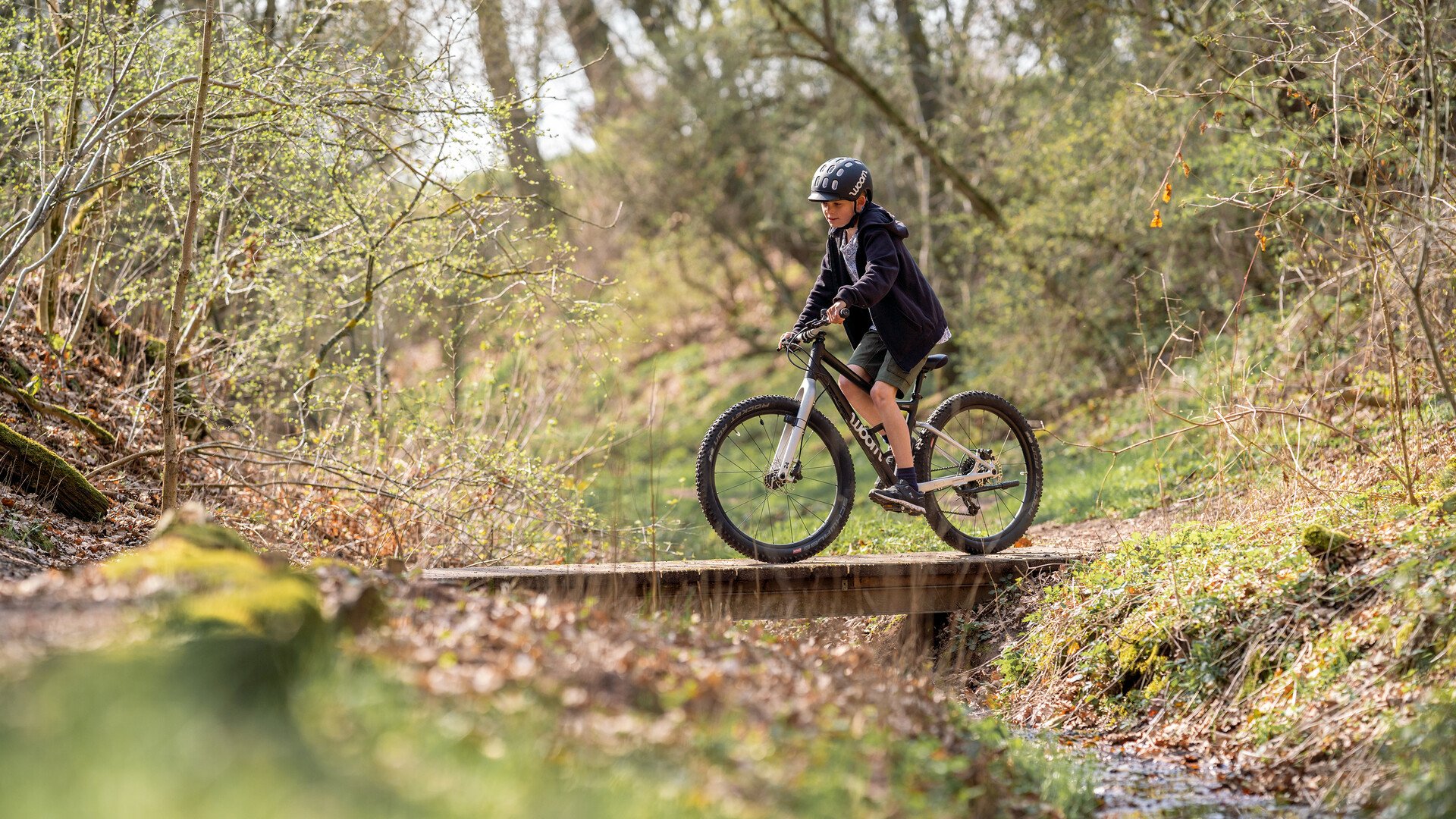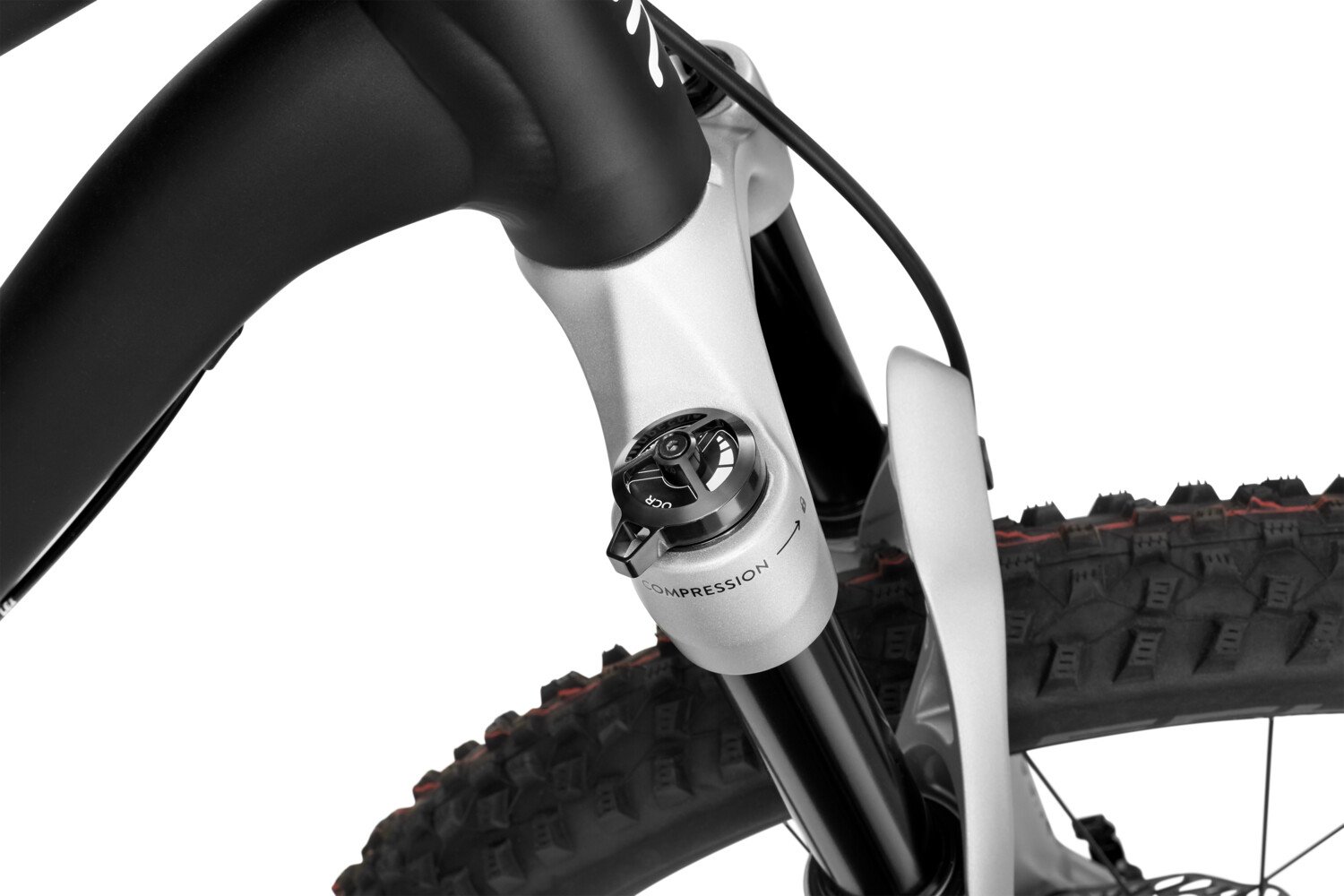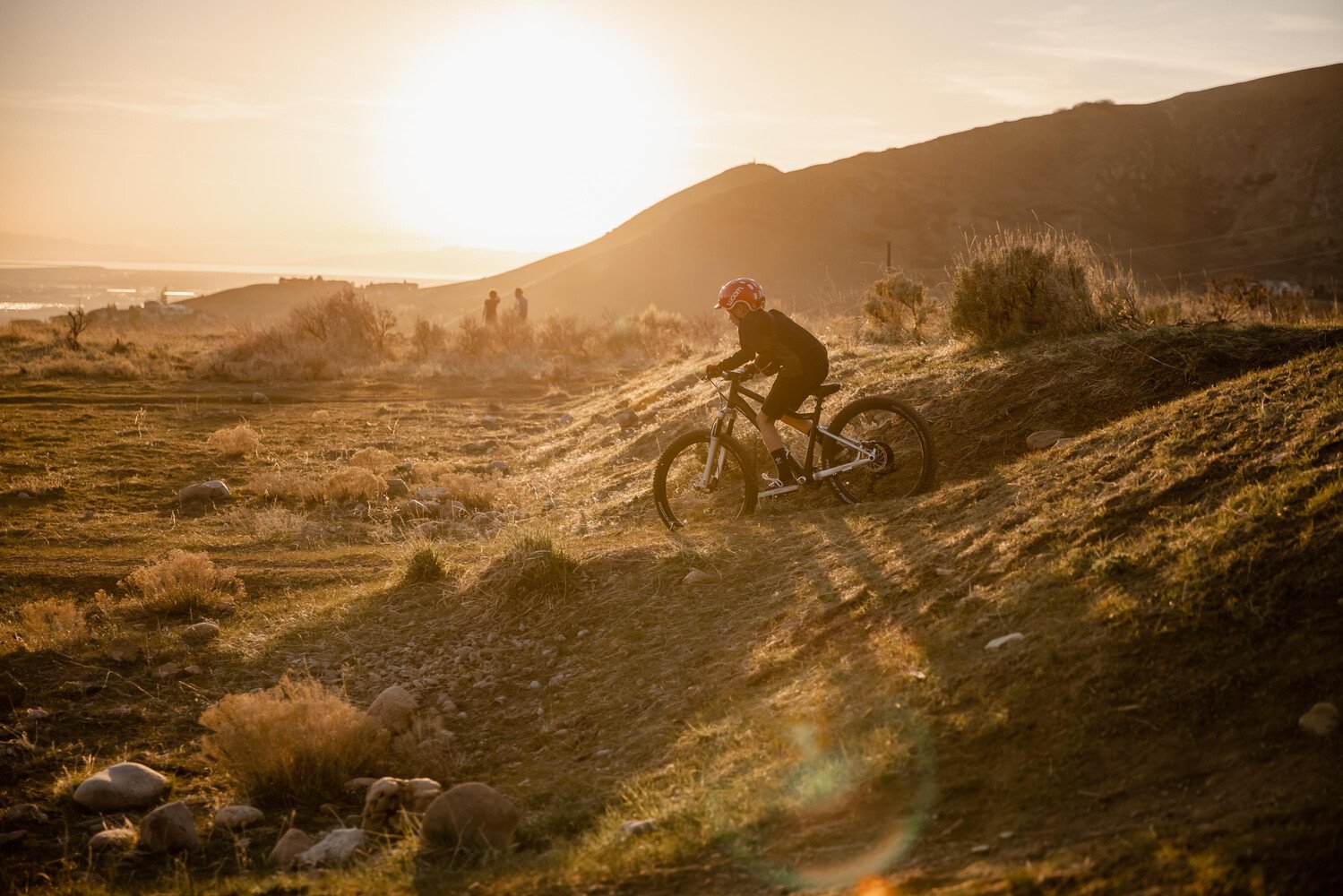The woom Guide to Kids’ Mountain Bikes and Suspension
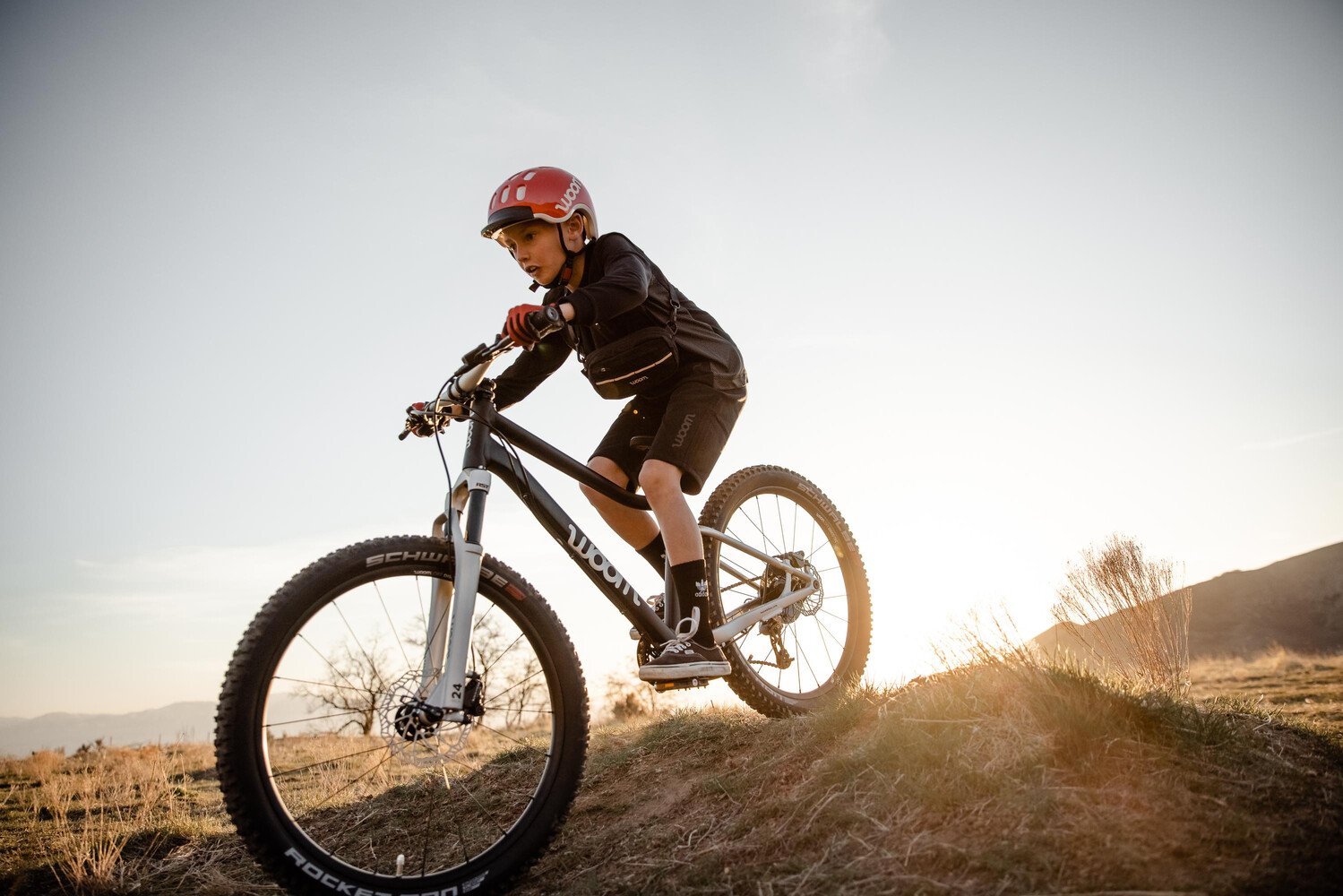
You can often let the wind decide where you’ll ride when mountain biking, but the wind won’t help you with the most pressing question right now: What type of kids’ mountain bike best suits your child? Rigid or front suspension? The woom OFF or the woom OFF AIR?
Whether on loose or lumpy soil, tackling steep or smooth terrain, from adventures in your local forest to rooty and rocky singletrack, mountain biking is a thrill for adults and kids alike. It’s time to learn what a difference suspension can make to your child’s off-road experience and better understand their bike’s potential. Ready to rip?
Rigid vs. Front Suspension: Explained
It’s probably best to start right at the beginning with the woom suspension 101: What is it, how does it work, and what’s the difference between a rigid mountain bike and one with front suspension?
Suspension is designed to provide comfort and control when riding over bumps. On a mountain bike, this means cushioning from the terrain. As the word ‘rigid’ suggests, a rigid mountain bike has a traditional frame with no mechanical movement within it. With a rigid fork up front and a rigid rear triangle at the back, these bikes don’t have any significant flex or movement. If you ride over a root or rock, you’ll feel it in your wrists and feet. The woom OFF, with its rigid, superlight carbon fork, is a textbook example of a rigid mountain bike.
On the flip side, a front suspension or ‘hardtail’ mountain bike has a suspension fork that has a set amount of movement (also known as ‘travel’) to absorb the majority of impacts taken by the front wheel as it passes over rough terrain. Its purpose is to minimize the amount of energy transmitted to the rider. Think of the woom OFF AIR with its air-sprung suspension fork. This is known as a hardtail mountain bike because it has no rear suspension.
Many serious downhill-oriented mountain bikers ride bikes with full suspension, or ‘fullies’. They have movement at both ends of the bike provided by a suspension fork and a rear shock. For very, very rough terrain, this is the sort of capability needed for charging down the mountainside rather than tiptoeing through it.
Rigid vs. Front Suspension: Consider the Rider
Now you have the basics of suspension, let’s look at the type of riders and scenarios that warrant suspension.
Does your kid enjoy riding around their neighborhood and exploring their woods? Do they mainly stick to dirt tracks or mellow terrain? Are they unlikely to come across more than just a few roots and bumps? Are they particularly light for their age and/or smaller than their classmates?
If you answered ‘yes’ to most of the above, then your child would probably benefit more from a capable rigid bike with large volume tires and well-balanced geometry, like the woom OFF, rather than dealing with the added weight and complexity of having front suspension.
What’s great about a rigid kids’ mountain bike is how it helps them develop their off-road skills. The beauty of this is that the riders themselves are the suspension: By stripping away the assistance and comfort that front suspension provides, your child’s off-road ability will rocket as they learn how to pick smoother lines over the terrain, as well as how to use their arms, legs, and upper body to absorb the impacts (something that they’ll really benefit from later as they progress in the mountain bike world).
Does your child love shredding trails? Are they addicted to all things MTB and continually pushing you to seek out tougher trails to test their limits? Are they of normal weight for their age, and ride aggressively, or energetically, when off-road?
If yes, then a front suspension mountain bike, like the woom OFF AIR, would be the key to further unlocking their passion for off-road riding. You’ll probably recognize when they’re getting into terrain that justifies the added cost and weight that come with suspension. Fast and bumpy descents? Loose climbs? Tight turns? On designated MTB trails or at a bike park, your child will need more control, better traction, and better braking. Here’s where the suspension comes into play. Having this travel up front also prolongs the onset of fatigue in your child’s hands and wrists by smoothing out the constant vibrations of riding off-road, so they’ll be able to enjoy longer rides. Did someone say arm pump? No chance!
Rigid vs. Front Suspension: Advantages to Each
When it comes to forks – whether rigid or suspension – not all of them are born equal. If we take a closer look at the rigid fork on the woom OFF, you’ll see it is made out of carbon fiber. Yep, the very same material that’s the holy grail of lightweight adult racing bikes. This doesn’t just massively save weight, meaning less load for the rider to carry uphill, but also provides sky-high torsional rigidity that translates into exceptional steering precision. If you want to dart between trees or quickly change your line, this is the bike for that. Unlike cheaper metal rigid forks, the woom OFF’s ultra-low weight makes it particularly suited for kids, with the nominal side-to-side flex boosting confidence when ripping the turns. Of note, the woom OFF’s high-volume tires can be ridden at a lower pressure, giving a small amount of cushioning on rough terrain—just watch out for punctures. There’s also a degree of natural compliance in the carbon fork that can take the edge off rough trails too.
The same steadfast focus on a superior ride also applies to the woom OFF AIR, where we’ve opted for an air-sprung suspension fork. The reasoning behind our decision is multifold:
- Air-sprung suspension is significantly lighter than its coil-sprung counterpart, which really matters to kids when they ride.
- Air-sprung suspension offers better functionality with smooth and controlled travel.
- The woom OFF AIR’s fork delivers better responsiveness for lighter riders through its low activation weight.
- And finally, air-sprung suspension has a high degree of built-in adjustability so that all kids – regardless of their weight – can make full use of the fork’s small and large bump damping.
Through the adjustable compression and rebound damping, you can tune the fork’s behavior to your child’s riding style and the bumpiness of the terrain—basically adjusting the speed at which the suspension goes up and down. Go soft and supple, or more stiff and supportive, depending on how you turn the dials. (Don’t worry, we include the instructions!) There’s also a lock-out function for the climbs, which basically switches off the movement of the suspension to make it easier for your kid to ride up the top of the next fun and flowy descent.
Rigid vs. Front Suspension: Serviceability
Without any moving parts, a rigid fork doesn't really require any special service on top of regular cleaning. But it’s a different ballgame once you add a suspension fork to your bike and start shredding on the daily. Depending on how often your child rides, how hard they ride, and the conditions they ride in, their fork parts will need servicing and sometimes replacing to keep them working at their best. Don’t be deterred; the fork can easily be serviced by a local, qualified bike mechanic, while basic maintenance is all part of the joy of mountain biking, we promise.
Think of this sometimes-puzzling part of the suspension journey as a joint adventure, and embrace the opportunity to learn suspension 101 alongside your child. Sure, a well-maintained fork is great, but imagine how much bigger your child’s grin will be when they’re riding a well-maintained fork that’s optimally tuned for that particular ride.
Rigid vs. Front Suspension: Progression Over Time
Let’s not look at rigid versus front suspension as an irreversible fork in the road. Instead, think of it as a progression. A young rider begins on a rigid mountain bike, then, as their riding skills progress, they might move up to a front suspension mountain bike, before eventually stepping up to a full suspension mountain bike – if their riding style dictates it, and their pockets are full of lift-passes for the bike park.
We say go for it. Get the basics down, ride new and unfamiliar terrain, see what’s left, right, behind your house, over the hill and beyond. Empower your child by ensuring they’ve got the right bike at the right time, and letting them learn the necessary skills at each step of their mountain biking journey. Tweak their suspension set-up as it best suits them. The more they progress, the deeper their passion will become, and the more magic moments you’ll share.
Once you have a mountain bike, all that is left is the easy bit: Riding and having fun.

